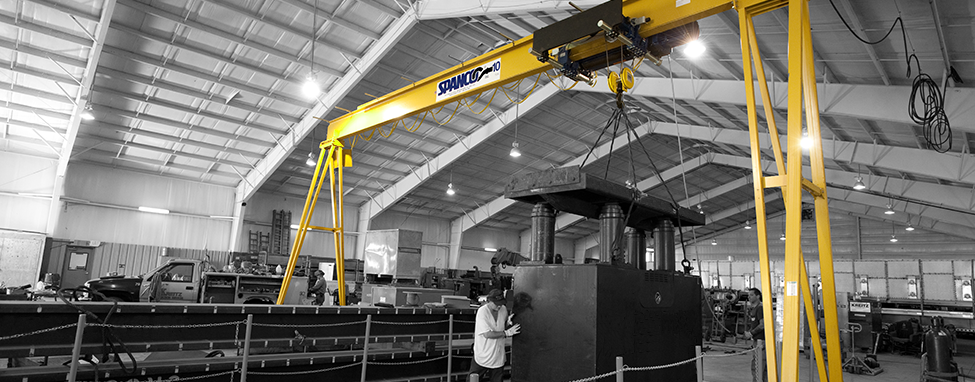
Three Ways to Boost Productivity with Overhead Lift Solutions
Apr 6, 2017
From small machine shops to giant steel mills, overhead cranes have helped thousands of facilities achieve measured improvements in safety and ergonomics, worker autonomy/personnel reduction, reduced workflow bottlenecks, and productivity.
Versatility and Flexibility: Find the Perfect Crane to Meet All of Your Lifting Needs
Overhead cranes are extremely versatile tools meant to provide a flexible lift solution for a variety of applications and industries. There are hundreds of overhead crane models, and most cranes are easily customized to meet the needs of an individual application. Depending on the operation, finding the right overhead crane is an important part of ensuring flexibility and versatility on your shop floor, construction site, or factory. Gantry cranes, for instance, can be three-way adjustable in span, height, and tread. This allows operators to alter the span, height, and tread to fit through narrow aisles, increase trolley-hook height, and lengthen the span as needed. This is perfect for workers who need to lift materials in multiple locations or are lifting materials that vary in shape and size. Gantry cranes are also fully portable, meaning they can be moved from one job site to another or from one workstation to another, quickly and easily. In fact, most gantry cranes can be moved manually under load by one or two workers. Aluminum gantry cranes can be quickly assembled and disassembled, making them ideal for multiple site applications.
Maintain Constant Material Flow: Keep Your Operation Running at Peak Performance
It’s no secret that manufacturing facilities need to maintain a constant flow of materials. Every manufacturing company wants to streamline their manufacturing process, from incoming raw materials to fabrication, packaging, and shipping. An interruption in the manufacturing process will inevitably decrease production. But, the right lift equipment can help maintain your workflow and streamline your production process.
Maintaining a constant flow of materials in your production facility is not an impossible task. In fact, with the right tools, it can be downright easy. As a benefit, you will improve profits by maximizing production and decreasing downtime using the appropriate lift equipment for your application.
There’s obviously more to a proficient production process than lift equipment. But, when your workers are equipped with the right solutions, workflow and safety are greatly improved. There are dozens of overhead crane systems that will improve production and help to maintain a constant flow of working materials, but every application is different.
If your facility is set up in workstations, your workers probably have to share a large overhead crane to move materials from one work area to another. Waiting on the overhead crane creates unnecessary downtime, and although that large overhead crane is important to your operation, supplementing it with a series of wall-mounted or tie-rod jib cranes is a cost-efficient way to ensure each work area is equipped with an overhead lift system and downtime is eliminated. Wall-mounted jib cranes require no floor space and no special foundation. They quickly fold out of the way of large overhead cranes, offering the greatest amount of clearance above and below the boom.
Worker Safety: Prevent Worker Downtime with Appropriate Lift Systems
Worker safety is—arguably—the most important reason we encourage companies to purchase and install the correct overhead lift solution for their specific application. Protecting your employees is essential to the success of your operation, and safety rules are regulated by OSHA 1910.179.
The purpose of overhead lift systems is to move products safely and improve efficiency. But, there’s another reason it’s important to install and use the correct type of lift system and keep workers as safe as possible on the job: the enormous costs associated with accidents.
According to the National Institute for Occupational Safety and Health (NIOSH), American industry pays out 10 to 14 billion dollars in workers’ compensations costs and about 100 million work days each year. Over the years, it’s become more commonplace for workers to use material handling solutions to lift and transfer heavy loads. But, there is still a disconnect with light-load lifting.
Today, there are still many companies whose workers lift “light” loads manually, contributing to the statistics of worker injuries. Even lighter loads weighing 25, 50, or 75 pounds can cause workplace injury due to the monotonous movement of the worker’s body as he or she lifts and transports materials.
Installing an overhead crane aligned with your application’s specific needs will drastically decrease worker’s compensations costs and sick days, medical expenses, lost work time, potential lawsuits, and any applicable OSHA fines. It will also keep your workers safer as they move through their daily routines.
Using overhead cranes can provide multiple safety benefits and improved productivity on the shop floor. They minimize employee labor, provide easy lift solutions for increased efficiency, and reduce injuries caused by improper lifting and falling materials.
Categories
Share this post
Contact us
Looking for the perfect fall protection equipment? Let us help!
